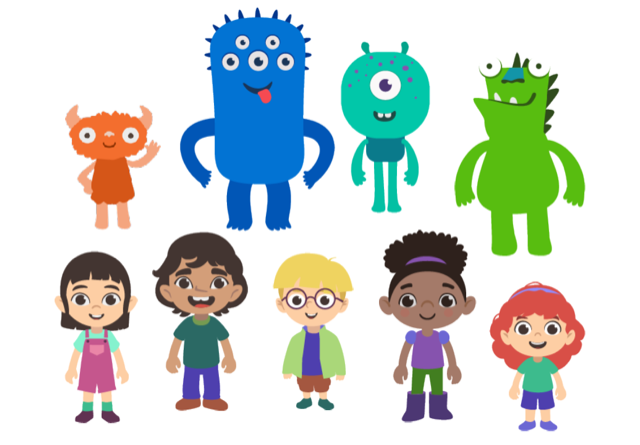Character Design Process
- Adrian Aguirre and Phil McVann

- Jul 7, 2021
- 3 min read
Updated: Sep 29, 2021
One of the most exciting things that we get to do in the Department of Innovative Media Research & Extension is designing and creating characters. These characters are often some of the most appealing art assets that we create. However, character design doesn’t start at the drawing board. There are many considerations, such as what purpose the character will serve in the project.
Characters aren’t necessary in all projects, and it is important to consider whether adding characters to a game or animation will help with the user experience and the learning objectives. At times we’ve used simple characters to help explain abstract concepts in a very relatable way. For example, in our Cation Exchange video, the personification of atoms—adding smiles, grunts, and high fives—helped explain how atoms and molecules react and move in soil.

We’ve also used characters to guide users. A character that gives instruction can be more engaging than a simple text box. Even when the characters are not essential to the game mechanic, such as in Ratio Rumble (a math game available on MathSnacks.org), allowing users to make a character selection can increase engagement with the game.
We also use characters to communicate other messages: Correct character design can normalize certain behaviors, influence standards for who is considered credible, and help users or viewers connect with the content.
Because all projects are different, we consider what function or purpose the character is going to have in the project. How big of a role will the characters have in the game or animation? If characters only appear for a few seconds in an animation or game, they can be more or less generic—whereas a game avatar or a level boss needs to have more individuality and complexity.
It’s often helpful to think of a backstory for each character, even when this story isn’t revealed to the user. Who are they? What do they like to eat? What sort of voice would they have? These questions help us build characters that have personality and individuality.
We also have practical considerations that are based on budget and technological limitations. If a character needs to be animated programmatically, or if it needs to be a low polygon 3D model, this will guide how the character will be designed. A simple spaghetti-like limb can be more easily animated than a more realistically rendered arm.
The amount of abstraction and stylization we use is also guided by the audience. Bright primary colors and simple shapes will be more appealing to younger audiences. Complex color palettes and dynamic shapes will attract an older age group. Regardless of what stylization is chosen, it is always important to make sure that the design is consistent. Even when they are drawn by different artists, having a style guide and palette is helpful to maintain character cohesiveness.
Designing appealing characters can be challenging, but there are a few strategies that are commonly used. Constructing bodies using simplified shapes helps abstract and stylize the human figure into a more graphical and graceful appearance. This is also useful when creating a character set. The contrast between characters comes about from starting each character with a distinct shape such as a tall rectangle for a torso vs a short oval. Stylization can also impact the overall tone of the project. Finding a style that fits well can continue to push the tonal narrative elements in the project
Posing the character further develops its personality. Since typically back stories are not shared, a considered pose can do much of the heavy lifting in regards to character personality. An animator can also envision how the character would move, when presented with carefully drawn poses. A good pose shows a clear and implied movement, often referred to as the line of action. The pose should also read clearly even at a glance. This is why designers will start with a silhouette of the pose, to see if there is anything visually ambiguous about the pose.
Through each iteration, details begin to emerge. The amount of detail and complexity appropriate for a given character is determined by the purpose that it serves. The character’s back story informs how attire and props are designed. If it is to be animated, then additional poses and facial expressions are drawn in what is referred to as a character sheet.
Written by:
Adrian Aguirre, Artist & Studio Manager, adaguirr@nmsu.edu
Philip Mc Vann, Artist, pmcvann@nmsu.edu








